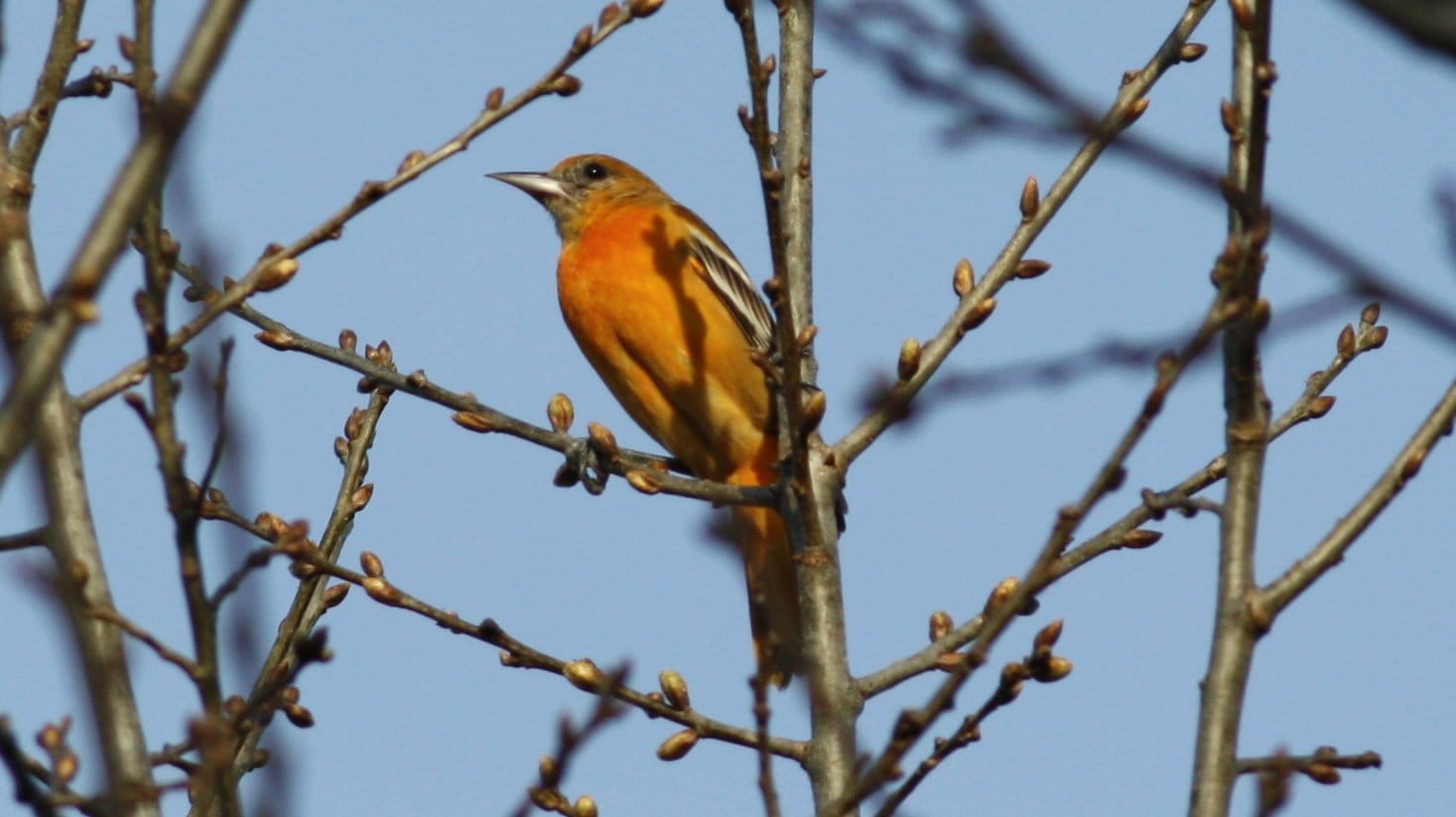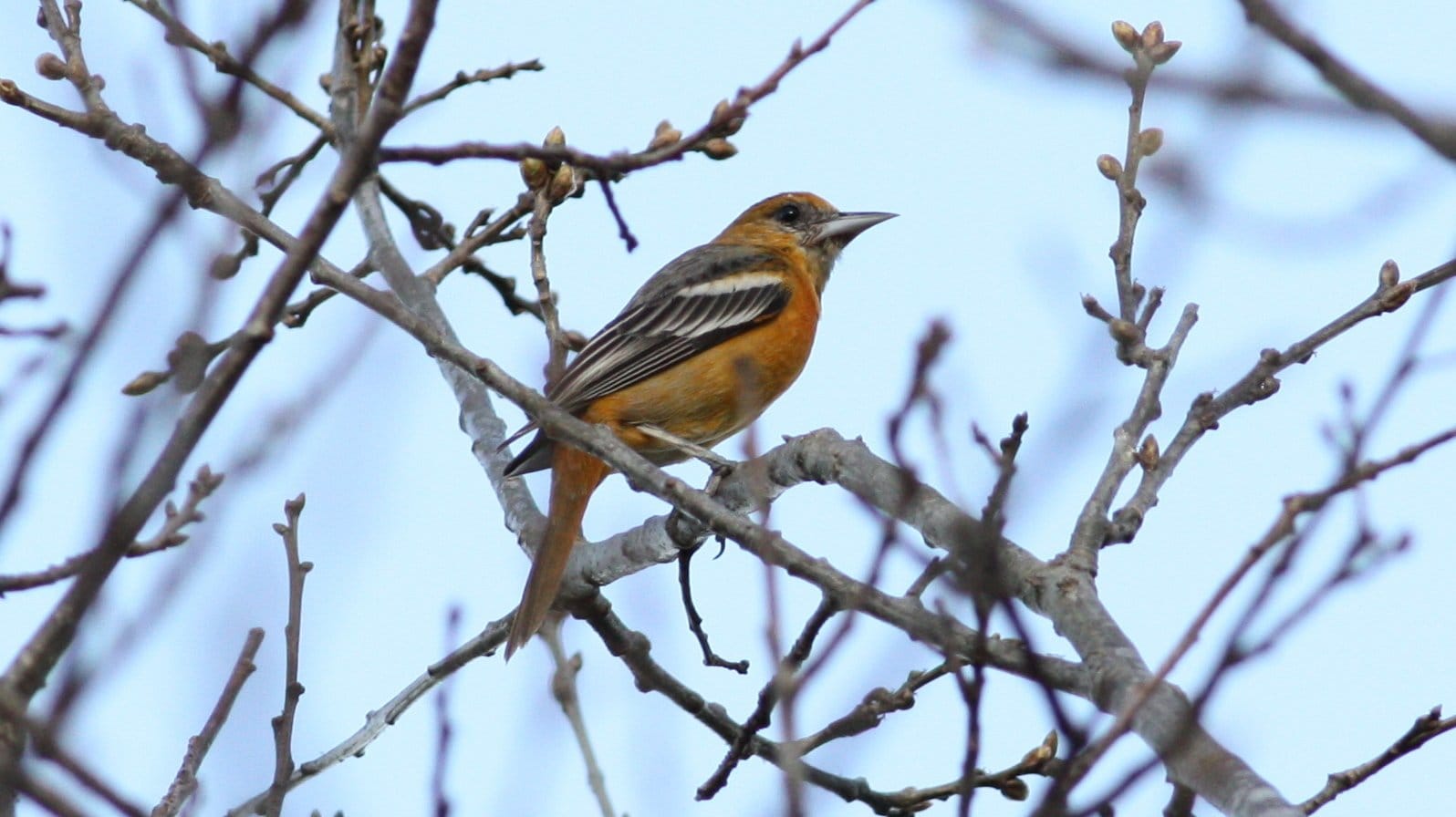This past Monday I was running around with my son in my backyard after work. We were doing the regular stuff; waiting for the mail truck, pointing at city buses, running hap-haphazardly across the lawn and up into neighbors patios. I can’t help it, there’s just so much interesting stuff up there. I chanced to glance at a bird perched atop the Oak tree in my back yard, figuring it was one of the Blackbirds or Grackles that had recently returned to my neighborhood. Instead I saw a flash of orange. Not a minute later, I’d scooped up my kid and sprinted back into the house for my binoculars and camera.

The vast majority of Baltimore Orioles that breed in North America return to the tropics between Mexico and northern South America for the cold half of the year. They are, for many birders in the eastern part of the continent, one of a short list of quintessential spring birds. The thought of an Oriole foraging in bare winter branches is as foreign as a Petrel on a pool and yet, there it was in my yard picking through an abandoned squirrel’s nest for what appeared to be spiders. The truth is, wintering Baltimore Orioles are unusual, but not unheard of, in the southeast. Many winter in Florida, admittedly something of a freak state when it comes to overwintering passerines, but a few Orioles can be found up the coast as far north as North Carolina, and the odd bird finds its way into the Piedmont, the part of the state, well inland mind you, where I live. As you might imagine, even fewer show up in my yard.
When I began birding with people from parts farther north I became familiar with the term “Half Hardy“, which refers to those species of birds who are generally present in small numbers during mild winters, but usually can’t handle the rough patches of extreme cold temperatures and snow that are less frequent. During the SuperBowl of Birding in Massachusetts my team (and Corey’s), the Bloggerhead Kingbirds, searched more or less tirelessly for birds like Hermit Thrushes and Brown Thrashers and Eastern Bluebirds. Fruit and bug eaters are overrepresented in the half hardy roster and the reason for this is fairly obvious; bugs are nonexistent in extreme cold, and fruit is inconsistent and often jealously guarded. It’s tough out there for a bird, especially one that doesn’t eat black oil sunflower seeds.
The reason I hadn’t come across the term before was fairly obvious too. Southern winters are generally not that harsh. Bugs may slow down, but there are always some around. Berries, of both native and non-native (ugh) varieties, are abundant. Thrushes, Thrashers, and Bluebirds are found across the south in large numbers, along with Carolina Wrens, Eastern Phoebes, and Yellow-rumped Warblers and several other species of birds that are rare to uncommon farther north.
But how does the apply to Orioles?

Even though our winters are milder with abundant food, we still have our own band of half hardies. The Oriole is only one, but a mild winter can mean good numbers of birds like Blue-headed Vireos and even Yellow-throated Warblers down here. A trip to the coastal plain may net you up to seven species of warblers, from the omnipresent Yellow-rumps to Chats and Cape Mays. Winter Orioles are still unusual – as are any of these birds really – but they’re around. Common enough, apparently, to show up at a completely average row of townhomes in the NC Piedmont.
I’ve got oranges out just in case it comes back. It may only be half hardy, but I’ll try to make sure it has what it needs to make it through any bad weather winter has yet to throw at us.











Beautiful shots of one of my favorite birds. Thanks for sharing these, Nate!
Half hardies are one of the few fun parts of birding up north in winter. Catbirds, yellow-rumps, and Hermit Thrushes are much more exciting in the depths of winter then they are in spring.